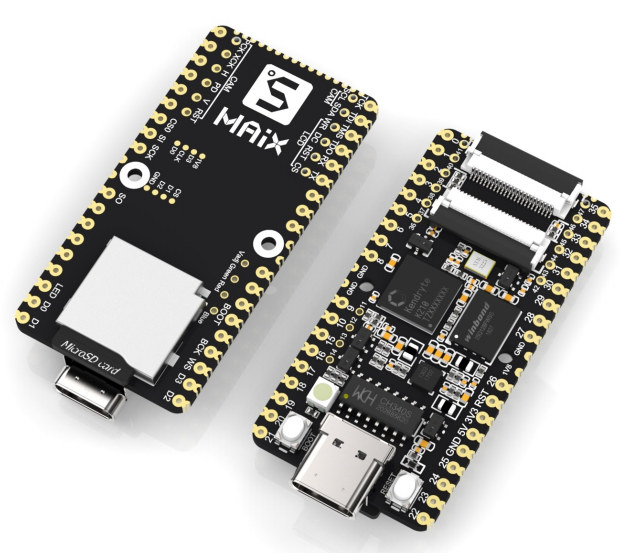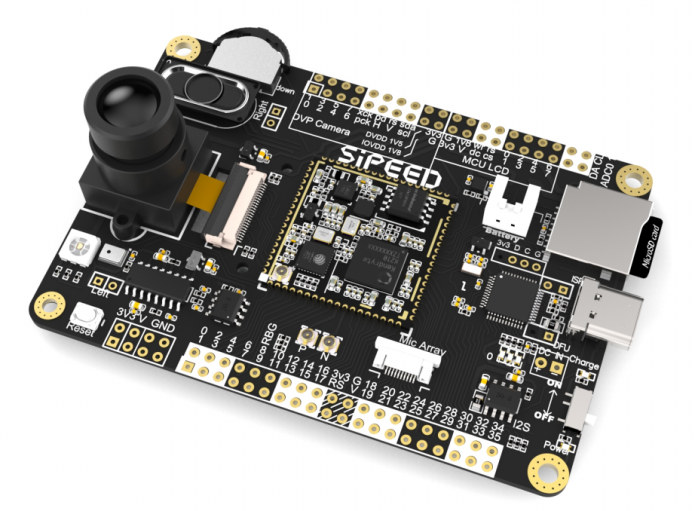Sipeed M1 (aka MAIX-I)is a compact module based on Kendryte K210 dual core RISC-V processor designed for low power artificial intelligence workloads at the edge, such as face detection, object recognition, or audio processing.
The module and some development boards are available on Taobao for the Chinese market, as well as YOYCart for the rest of the world, but the company has now launched several MAIX boards based on M1 module through an Indiegogo campaign with price starting at just $5 a piece.
 Sipeed MAIX Bit (aka MAIX Micro) is the cheapest one at $5 (early bird) / $6 with the following specifications:
Sipeed MAIX Bit (aka MAIX Micro) is the cheapest one at $5 (early bird) / $6 with the following specifications:
- SoC – Kendryte K210 dual core 64-bit RISC-V processor @ 400 MHz (overclockable up to 800 MHz) with
- KPU CNN hardware accelerator
- APU audio hardware accelerator with support for up to 8 mics, up to 192 KHz sample rate
- FPIOA (Field Programmable IO Array) mapping 255 functions to all 48 GPIOs on the chip.
- 8 MB general purpose SRAM including 5.9MB usable as AI SRAM memory
- AXI ROM to load user program from SPI flash
- Storage – micro SD card slot, 8MB SPI flash
- Display I/F – MCU LCD FPC connector for optional 2.4″ display
- Camera I/F – DVP camera FPC connector
- USB – 1x USB type-C port for power and programming
- Expansion – Breadboard friendly headers with UART, IIC, SPI, I2S, PWM, etc…
- Misc – 2x buttons, RGB LED
- Power Supply – Via USB type-C port
- Performance + Power Consumption – 0.25TOPS @ 0.3W ,400MHz. 0.5 TOPS @ 800 MHz
- Dimensions – 5.08 x 2.54 mm
They also provide the M1 “Dan” Dock which I covered previously, so I’ll skip it in this post, as well as the full-featured MAIX GO board.
- SoC – Kendryte K210 dual core 64-bit RISC-V processor
- Storage – micro SD card slot
- Display – Optional 2.8″ LCD display
- Camera – Standard M12 lens DVP camera fitted to bottom or top of the board
- Audio – I2S microphone, speaker, Mic array connector
- USB – 1x USB type-C port for programming and power
- Expansion – All pins out via through holes
- Debugging – On-board JTAG & UART based on STM32F103C8 MCU
- Misc – RGB LED
- Power Supply – Via USB type-C port; Lithium battery management chip
- Dimensions – 88x60mm
The company also provide accessories for their boards include 2.4″ and 2.8″ displays, camera module, microphone and microphone array modules,
The MAIX boards and module support the original standalone SDK, FreeRTOS SDK base on C/C++, as well as a Micropython port called MaixPy with source code available on Github. You’ll find an overview of the board, and various vision and audio demo in the video below.
If you are interested, you can pledge $5 for MAIX Bit board, $16 for M1w Dan Dock suit with the dock, module, OV2640 camera, and 2.4″ QVGA LCD, as well as $22 for MAIX GO suit including the MAIX GO board, an M12 OV2640 camera, a 2.8″ QVGA LCD display, and a simple case. If instead you’d like Sipeed M1 module, they are offered in packs of 10 units for $55, unless you want the WiFi version for a total of $65. Various other rewards are provided check out the Indiegogo page for details. Shipping adds $5 worldwide, unless you select the $20 DHL option, and delivery is planned for November or December 2018 depending on the rewards.
Thanks to Gaiar for the tip.

Jean-Luc started CNX Software in 2010 as a part-time endeavor, before quitting his job as a software engineering manager, and starting to write daily news, and reviews full time later in 2011.
Support CNX Software! Donate via cryptocurrencies, become a Patron on Patreon, or purchase goods on Amazon or Aliexpress





